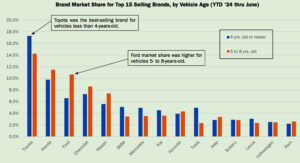The sharp increase from 2022 when the average yearly cost was only $10,728, or $894 monthly, is likely due to three factors
Orlando, Fla.—Based on the latest figures, the average cost of owning and operating a new vehicle in 2023 has increased significantly, with an annual expense of $12,182 or a monthly cost of $1,015. This is a sharp increase from 2022 when the average yearly cost was only $10,728, or $894 monthly, according to AAA’s Your Driving Costs (YDC).
“It’s important for car buyers to clearly understand the costs associated with owning a new vehicle,” said Greg Brannon, AAA’s director of automotive research. “Due to global supply chain issues and constrained inventory of new vehicles, car prices rose dramatically in 2022. And while the situation continues to improve, the spillover effects are keeping prices high.”
The overall average manufacturer’s suggested retail price (MSRP) of the new vehicles in the 2023 YDC study is $34,876. This is $1,575 (4.7%) higher than last year. It is important to note that MSRP does not always correspond to a consumer’s actual purchase price and may vary depending on demand. Furthermore, a higher sticker price directly impacts finance costs, with this year’s vehicles boasting an average annual finance charge of $1,253, a 90% increase from the previous year.
The change in the annual cost of owning a new vehicle is also likely driven by:
- Depreciation, which is the difference between the car’s value upon purchase and the value of the car when sold. According to this year’s YDC projections, new vehicles are expected to depreciate by an average of $4,538 per year over five years of ownership, up 24% over 2022.
- The jump in new vehicle prices (up almost $1,600) compared to used vehicle values that have experienced a decline in the past year.
- Automakers across the board have focused on producing more oversized, luxurious, and expensive vehicles, loaded with extra features that bump up prices even more.
Compared to last year, one of the higher annual cost categories was fuel, but this year’s average cost per mile has decreased by roughly 2 cents per mile. It’s worth noting that the cost of charging EVs has actually increased, by almost 2 cents per kWh over last year, from 13.9 cents per kWh to 15.8 cents per kWh. The increase is likely accounted for by higher-than-expected inflation, according to the U.S. Energy Information Administration (EIA).
Given their size, fuel economy, and prices, it should come as no surprise that ½-ton pickups have the highest average driving cost among all vehicle categories covered in the YDC study. The pickup truck market has slowed over the last 12 months as gas prices trend high and financial costs climb. Pickup trucks excel at hauling and towing, although many buyers do not use them for these purposes. Potential buyers should remember that the unique capabilities of pickups come at a high cost of over $1 per mile.
“The once popular pickup truck is now seeing a slight decline in demand as these vehicles have become increasingly expensive, rivaling the price of many luxury cars,” said Brannon. “As interest rates continue to climb, this adds a layer of expense per month that consumers should consider when shopping for their next vehicle.”







Comments are closed.